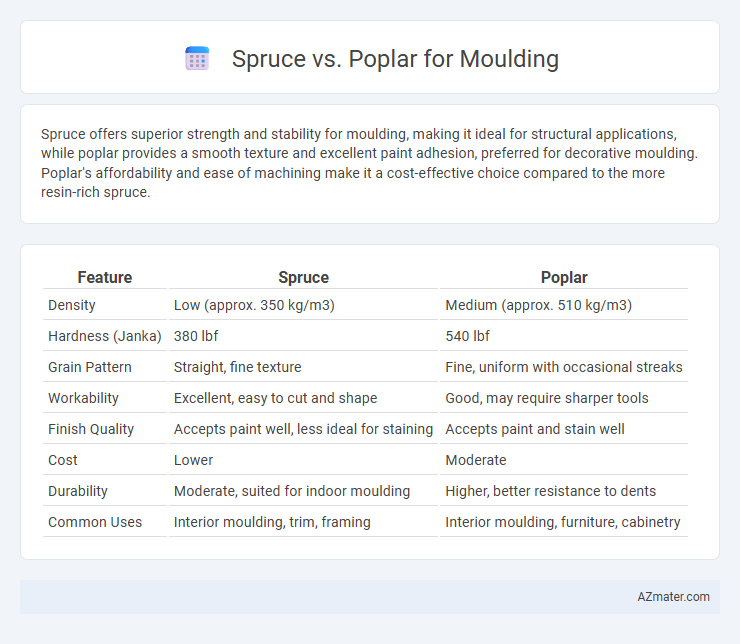Spruce offers superior strength and stability for moulding, making it ideal for structural applications, while poplar provides a smooth texture and excellent paint adhesion, preferred for decorative moulding. Poplar's affordability and ease of machining make it a cost-effective choice compared to the more resin-rich spruce.
Table of Comparison
| Feature | Spruce | Poplar |
|---|---|---|
| Density | Low (approx. 350 kg/m3) | Medium (approx. 510 kg/m3) |
| Hardness (Janka) | 380 lbf | 540 lbf |
| Grain Pattern | Straight, fine texture | Fine, uniform with occasional streaks |
| Workability | Excellent, easy to cut and shape | Good, may require sharper tools |
| Finish Quality | Accepts paint well, less ideal for staining | Accepts paint and stain well |
| Cost | Lower | Moderate |
| Durability | Moderate, suited for indoor moulding | Higher, better resistance to dents |
| Common Uses | Interior moulding, trim, framing | Interior moulding, furniture, cabinetry |
Introduction to Spruce and Poplar for Moulding
Spruce and poplar are two popular wood choices for moulding, each offering distinct characteristics suited to various applications. Spruce features a lightweight, softwood profile with a fine, uniform texture that is easy to machine and paint, making it ideal for decorative moulding and trim work in interiors. Poplar, a hardwood, provides greater durability and a smooth, consistent grain that readily accepts paint and stain, offering versatility for both complex and simple moulding designs.
Characteristics of Spruce Wood
Spruce wood features a light, creamy color with a fine, even texture that lends itself well to smooth moulding finishes. Its strength-to-weight ratio is high, making it durable yet easy to work with during cutting, shaping, and nailing. High resin content in spruce also provides natural resistance to decay and insect damage, enhancing the longevity of moulding applications.
Key Features of Poplar Wood
Poplar wood is prized for moulding due to its fine, even texture and smooth surface, which makes it ideal for painting and finishing. Its lightweight and relatively soft composition allow for easy cutting and shaping, offering versatility in intricate moulding designs. Poplar's consistent grain pattern minimizes splitting and warping, ensuring durability and a refined aesthetic for interior trim work.
Strength and Durability Comparison
Spruce offers superior strength-to-weight ratio, making it ideal for molding that requires structural integrity and resistance to warping. Poplar, while less dense, provides moderate durability with smooth grain suitable for painted finishes but is more prone to dents and wear over time. Choosing spruce over poplar results in longer-lasting molding, especially in high-traffic or high-impact areas.
Workability and Ease of Machining
Spruce offers excellent workability and ease of machining due to its straight grain and low density, making it ideal for intricate moulding details and smooth finishes. Poplar is also easy to machine, but it is slightly denser and has a more uneven grain, which can cause minor challenges in achieving fine moulding profiles. Both woods accept nails and adhesives well, but spruce is preferred for projects requiring precise cuts and reduced tool wear.
Finishing and Paintability Differences
Spruce moulding features a uniform grain that accepts paint and finishes smoothly, making it ideal for detailed and clean coatings. Poplar moulding offers excellent paintability due to its fine, even texture, often resulting in a smoother final finish with less sanding required. While Spruce may need more surface preparation to prevent blotchiness, Poplar's natural consistency enhances paint adhesion and reduces the risk of uneven coloring.
Cost and Availability Analysis
Spruce moulding typically offers lower costs due to its faster growth and widespread availability in North America, making it a budget-friendly choice for large projects. Poplar moulding, while slightly more expensive, provides more consistent supply and is favored for its smooth grain and ease of painting, often justifying the higher price for detailed finishing work. Both woods are readily available, but spruce's abundance leads to more competitive pricing, whereas poplar's cost can fluctuate based on regional demand and quality grades.
Environmental Impact and Sustainability
Spruce moulding is known for its rapid growth and renewable nature, making it a more sustainable option compared to poplar, which grows slower and requires more resources. The lower density of spruce results in reduced transportation emissions due to lighter loads, while poplar's higher density can increase carbon footprint during distribution. Spruce's quicker regeneration rate and ability to thrive in diverse climates contribute to a smaller environmental impact relative to poplar in moulding applications.
Best Applications for Spruce Moulding
Spruce moulding is best suited for interior trim and decorative applications due to its lightweight nature and fine, straight grain, which allows for smooth finishing and easy painting. Its moderate strength and stiffness make it ideal for window casings, baseboards, and crown moulding where detailed profiles are required without added weight. Compared to poplar, spruce offers better dimensional stability in dry indoor environments, reducing the risk of warping and making it a preferred choice for precise architectural moulding installations.
When to Choose Poplar over Spruce
Choose poplar over spruce for moulding when you need a stable, smooth surface that accepts paint well, especially for interior trim or decorative details. Poplar's fine, even grain resists warping and dents better than spruce, making it ideal for intricate profiles and painted finishes. Opt for poplar in applications requiring a durable, paintable moulding with fewer knots and consistent texture.

Infographic: Spruce vs Poplar for Moulding
 azmater.com
azmater.com